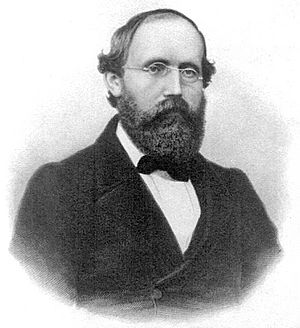Bernhard Riemann facts for kids
Quick facts for kids
Bernhard Riemann
|
|
|---|---|

Riemann c. 1863
|
|
| Born |
Georg Friedrich Bernhard Riemann
17 September 1826 Breselenz, Kingdom of Hanover (modern-day Germany)
|
| Died | 20 July 1866 (aged 39) |
| Alma mater | |
| Known for | See list |
| Scientific career | |
| Fields | |
| Institutions | University of Göttingen |
| Thesis | Grundlagen für eine allgemeine Theorie der Funktionen einer veränderlichen complexen Größe (1851) |
| Doctoral advisor | Carl Friedrich Gauss |
| Other academic advisors |
|
| Notable students | Gustav Roch Eduard Selling |
| Influences | J. P. G. L. Dirichlet |
| Signature | |
Georg Friedrich Bernhard Riemann (born September 17, 1826 – died July 20, 1866) was a brilliant German mathematician. He made huge contributions to many areas of math, including analysis, number theory, and differential geometry. His ideas helped us understand how to measure things in complicated spaces and even laid the groundwork for Albert Einstein's theory of general relativity. Many people consider him one of the greatest mathematicians ever.
Contents
A Life of Numbers
Early Life and Talents
Bernhard Riemann was born in a small village called Breselenz in Germany. His father was a pastor, and his family was not wealthy. Bernhard was the second of six children. He was a very shy child and sometimes suffered from nervousness.
Even from a young age, Riemann showed amazing talent for math. He could do very complicated calculations in his head. His teachers were often surprised by how quickly he understood difficult math problems.
School and University
In 1840, Riemann moved to Hanover to live with his grandmother and attend school. Later, he went to high school in Lüneburg. He studied the Bible a lot, but his mind was always drawn to mathematics.
When he was 19, in 1846, he started studying philology (the study of language) and Christian theology at the University of Göttingen. His plan was to become a pastor, like his father, to help his family financially.
However, at Göttingen, he met the famous mathematician Carl Friedrich Gauss. Gauss saw Riemann's incredible math skills. He told Riemann that he should focus on mathematics instead of theology. With his father's permission, Riemann switched to studying math. He also studied at the University of Berlin for two years, where he learned from other great mathematicians like Peter Gustav Lejeune Dirichlet.
Working as a Professor
In 1854, Riemann gave his first lectures as a professor. These lectures were very important because they started a new field of math called Riemannian geometry. This new geometry later became a key part of Albert Einstein's famous theory of general relativity, which explains how gravity works.
In 1859, Riemann became the head of the math department at the University of Göttingen. He was also one of the first to suggest that there could be more than three or four dimensions in reality, which was a very advanced idea for his time!
In 1862, he married Elise Koch, and they had a daughter named Ida.
Final Years
Sadly, Riemann suffered from tuberculosis, a serious illness. He traveled to Italy several times for his health. He passed away in Italy in 1866, at the age of 39.
Riemann was a very religious person, just like his father. He believed that his work in mathematics was another way to serve God. He died while reciting a prayer with his wife. After his death, some of his important unpublished math papers were accidentally lost.
Riemann's Big Ideas
Riemann's work connected different areas of math, especially analysis (the study of change) and geometry (the study of shapes and spaces).
Riemann Surfaces
One of his important ideas was the introduction of Riemann surfaces. These are special surfaces that help mathematicians understand complex numbers and functions in a more visual and geometric way. This idea is still used today in many parts of math and mathematical physics.
Riemannian Geometry
In 1853, his teacher, Carl Friedrich Gauss, asked Riemann to write a paper about the basic ideas of geometry. Riemann spent many months working on it. In 1854, he gave a lecture about his new theory of higher dimensions. This lecture was published after his death and is now seen as one of the most important works in geometry.
This work created the field of Riemannian geometry. Riemann figured out how to extend the study of curved surfaces (like the surface of a ball) into many dimensions. He showed that to describe distances and curves in a space with four dimensions, you need ten numbers at each point. This idea was crucial for Einstein's theory of general relativity, which describes the universe as a curved four-dimensional space-time.
Images for kids
See also
 In Spanish: Bernhard Riemann para niños
In Spanish: Bernhard Riemann para niños


